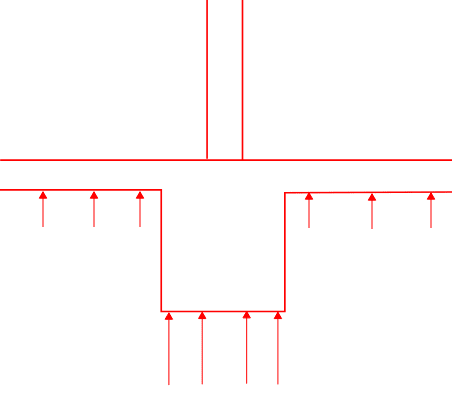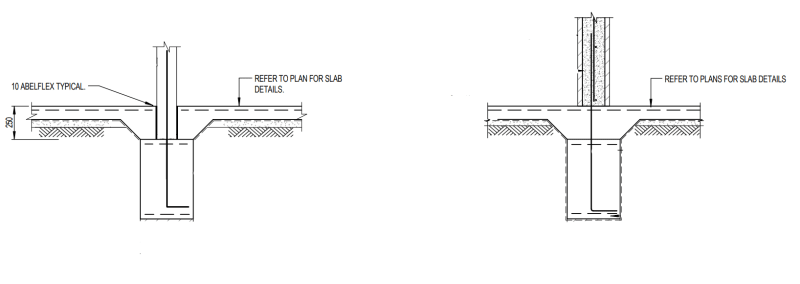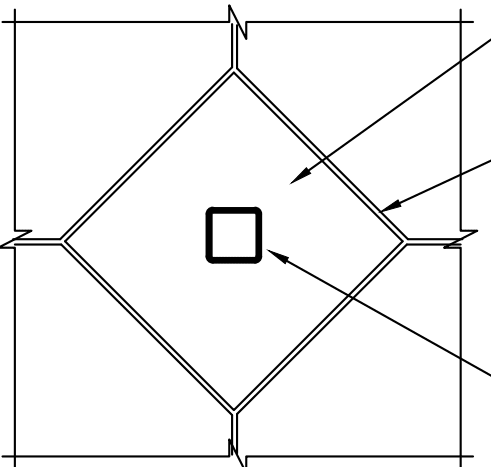Navigation
Install the app
How to install the app on iOS
Follow along with the video below to see how to install our site as a web app on your home screen.
Note: This feature may not be available in some browsers.
More options
Style variation
-
Congratulations cowski on being selected by the Eng-Tips community for having the most helpful posts in the forums last week. Way to Go!
You are using an out of date browser. It may not display this or other websites correctly.
You should upgrade or use an alternative browser.
You should upgrade or use an alternative browser.
Wall to footing detail.
- Thread starter _Luke-Eng
- Start date
- Status
- Not open for further replies.
GeorgeTheCivilEngineer
Structural
This is as much a matter of construction sequencing than engineering issues. Either detail can be made to work.
Main differences are
- slab on right is continuous so needs to be considered as a large panel
- may have hogging over the foundation
- is connected to the foundation
- slab shrinkage and rotation in the wall (especially at edges)
Probably other more obvious things I can't think of at the moment...
I would always prefer the left hand one since I don't want to tie the wall and slab together. Plus you get a bit of shelter for casting the slab.
Main differences are
- slab on right is continuous so needs to be considered as a large panel
- may have hogging over the foundation
- is connected to the foundation
- slab shrinkage and rotation in the wall (especially at edges)
Probably other more obvious things I can't think of at the moment...
I would always prefer the left hand one since I don't want to tie the wall and slab together. Plus you get a bit of shelter for casting the slab.
As mentioned above, this has a lot to do with the construction method.
I see the left side detail as a concrete wall, formed and poured to the foundation. You could achieve a similar detail with CMU. It looks like you have a spread footing under that wall (or improperly drawn grade beam?)... I've typically seen these spread footings with a shallower depth and wider width (hence to spread the load and achieve proper soil bearing). Also depends where you're cutting the soil. Some locations won't allow for such a nice vertical cut as you've shown and will require forms.
The right side detail looks like a monolithic slab. For locations that achieve a decent soil bearing capacity, the haunch can be designed (deeper and wider than shown) to take out the vertical load, and you wouldn't require the foundation pour below. This way the GC doesn't have to stage two different pours. To me, the spread footing below the wall & slab defeats the purpose. If you had a concentrated column load that might be a different case. Either way, this slab is continuous and you'll have to give consideration to negative moment over the support (think double layer of top reinforcing).
Keep in mind, there are many ways to go about these details.
I see the left side detail as a concrete wall, formed and poured to the foundation. You could achieve a similar detail with CMU. It looks like you have a spread footing under that wall (or improperly drawn grade beam?)... I've typically seen these spread footings with a shallower depth and wider width (hence to spread the load and achieve proper soil bearing). Also depends where you're cutting the soil. Some locations won't allow for such a nice vertical cut as you've shown and will require forms.
The right side detail looks like a monolithic slab. For locations that achieve a decent soil bearing capacity, the haunch can be designed (deeper and wider than shown) to take out the vertical load, and you wouldn't require the foundation pour below. This way the GC doesn't have to stage two different pours. To me, the spread footing below the wall & slab defeats the purpose. If you had a concentrated column load that might be a different case. Either way, this slab is continuous and you'll have to give consideration to negative moment over the support (think double layer of top reinforcing).
Keep in mind, there are many ways to go about these details.
- Thread starter
- #4
Thank you for your response.
I have seen the LHS one a lot more. The RHS is really rare for me.
I thought it was because to the LHS one can separates walls from slabs and thus avoid heavy line load being applied to the slabs, causing different settlements in slab and maybe avoid cracking (I am not sure about this)
If I choose the RHS one, is there anything that I need to consider or can I simply replace the LHS with the RHS without changing anything?
I have seen the LHS one a lot more. The RHS is really rare for me.
I thought it was because to the LHS one can separates walls from slabs and thus avoid heavy line load being applied to the slabs, causing different settlements in slab and maybe avoid cracking (I am not sure about this)
If I choose the RHS one, is there anything that I need to consider or can I simply replace the LHS with the RHS without changing anything?
- Thread starter
- #5
Just strip footings. Walls can be either concrete or CMU
Can you please brief me about how to design this haunch? In fact, I don't know why haunch is required here, what if it is just a sudden change in slab depth as shown below? As you mentioned it will behave like a continuous slab. So without haunch it is like a typical slab-beam we normally have in suspended structure. So what is the purpose of haunch for both RHS and LHS one?

Can you please brief me about how to design this haunch? In fact, I don't know why haunch is required here, what if it is just a sudden change in slab depth as shown below? As you mentioned it will behave like a continuous slab. So without haunch it is like a typical slab-beam we normally have in suspended structure. So what is the purpose of haunch for both RHS and LHS one?

blihpandgeorge
Structural
as already said construction aspects are important. depends if they want to get the slab down first, or get some walls and columns up first so they can get the upper floor going. usually the slab down first is the norm i see so they dont have to be working on dirt for as long.
some further comment is that the left hand detail requires sealant around the column which has a maintenance aspect, it can also let water up and in if ground water ever got that high for what ever reason. i tend not to use the left hand detail in high spec occupied spaces for these reasons.
the left hand detail will also articulate and move if there is any heave or ground movement with such rotation becoming evident at the joint. the right hand detail is span for some movement, but will then just crack when it gets to its capacity.
as with many engineering details, neither is wrong per se, it is whether it is appropriate in a given situation
some further comment is that the left hand detail requires sealant around the column which has a maintenance aspect, it can also let water up and in if ground water ever got that high for what ever reason. i tend not to use the left hand detail in high spec occupied spaces for these reasons.
the left hand detail will also articulate and move if there is any heave or ground movement with such rotation becoming evident at the joint. the right hand detail is span for some movement, but will then just crack when it gets to its capacity.
as with many engineering details, neither is wrong per se, it is whether it is appropriate in a given situation
The main reason the left is more common is construction sequencing. With the left detail you can continue framing above the main floor without the trades finishing any of their work. With the right hand detail your mech and elec trades must finish their rough-ins before you can cast the floor and continue framing.
- Thread starter
- #8
JoshPlumSE
Structural
My belief is that the isolation joints are all about isolating settlement and cracking. If you've got multiple stories supported off of the one column (or wall), then there is likely to be SOME settlement of the foundation. But, the slab isn't really loaded very much, so it may not settle. Heck, it could even move up slightly in wet or freezing weather.
That's why allow for some differential movement between those structural items. In my experience, every time they replace the flooring, they'll look at the slab if the notice any cracks that are not obviously supposed to be there the occupants / owners will get way too excited about it.
That's why allow for some differential movement between those structural items. In my experience, every time they replace the flooring, they'll look at the slab if the notice any cracks that are not obviously supposed to be there the occupants / owners will get way too excited about it.
- Status
- Not open for further replies.
Similar threads
- Question
- Replies
- 2
- Views
- 8K
- Question
- Replies
- 2
- Views
- 10K
- Locked
- Question
- Replies
- 1
- Views
- 2K
- Locked
- Question
- Replies
- 6
- Views
- 3K
- Locked
- Question
- Replies
- 29
- Views
- 9K


